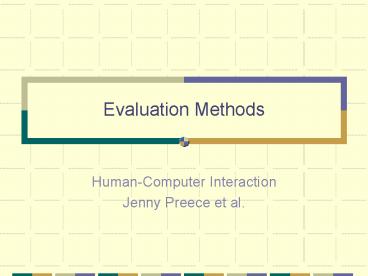Evaluation Methods - PowerPoint PPT Presentation
1 / 18
Title:
Evaluation Methods
Description:
The Hawthorne effect. Observation can change behaviour. Western Electric at Hawthorne, Illinois (1939) Also. The record is always incomplete ... – PowerPoint PPT presentation
Number of Views:458
Avg rating:3.0/5.0
Title: Evaluation Methods
1
Evaluation Methods
- Human-Computer Interaction
- Jenny Preece et al.
2
The HCI design model
- HCI design should
- be user-centred and involve users as much as
possible - integrate knowledge and expertise from different
disciplines - be highly iterative so that testing can be done
to check that the design does indeed meet user
requirements
3
The star life cycle (Hix Hartson)
4
The Hawthorne effect
- Observation can change behaviour
- Western Electric at Hawthorne, Illinois (1939)
- Also
- The record is always incomplete
5
Preeces classification of evaluation methods
- Usage data
- Experiments and benchmarking
- Interpretive evaluation
- Predictive evaluation
6
Usage data
- Observing users
- Direct and indirect observation
- Verbal protocols
- Thinking aloud method
- Software logging
- Time-stamped keypresses interaction logging
- Interviews
- Questionnaires
7
Questionnaire on User Interaction Satisfaction
(QUIS)
8
Experiments
- Traditional experiments
- Usability engineering
9
User-based evaluation process
10
Usability lab
11
Usability Engineering
- The process of usability engineering
- Defining usability goals through metrics
- Setting planned levels of usability that need to
be achieved. - Analysing the impact of possible design
solutions. - Incorporating user-derived feedback in product
design. - Iterating through the design-evaluate-design
loop until planned levels are achieved.
12
Interpretive Evaluation
- Contextual inquiry
- Cooperative and participative evaluation
- Ethnography
13
Contextual Inquiry
- Users and researchers participate to identify and
understand usability problems within the normal
working environment of the user. - Makes use of the contextual interview.
- Recommendations to evaluator
- Get as close to work as possible
- Uncover work practice hidden in words
- Create interpretations with customers
- Let customers expand the scope of the discussion
14
Ethnography
- a holistic interpretation of a groups culture
- Blomberg et al. (1993) highlight four main
principles that guide much ethnographic work - Ethnography is grounded in fieldwork - people are
studied in their natural settings. - To understand the influence of context on
peoples activities one must take a holistic
perspective. - Ethnographers build up a descriptive account of
how people behave, not how they ought to behave. - Importance is given to understanding things from
the point-of-view of those studied.
15
Predictive Evaluation
- Inspection methods
- Usage simulations
- Structured expert reviewing
- Modelling e.g. KLM
- Do not directly involve users
16
Structured expert reviewing
- Example Heuristic evaluation
- Expert reviewers examine the system guided by a
set of high-level heuristics. - A1 Match structure with user tasks.
- Does the structure of the website enable the
users to easily achieve their tasks? - 0 No problem 4 Usability catastrophe
17
Keystroke Level Model (KLM)
- Keystrokes (K)
- Pointing (P)
- Homing (H)
- Drawing (D)
- Thinking (M)
- Response (R)
- Example Enter the command put from the keyboard
and start its execution by striking the Enter
key. - MKpKuKtKEnter, or in shorthand
M4KputEnter
18
Differences between methods
- Factors
- Purpose of the evaluation
- Stage of system development
- Involvement of users
- Type of data































